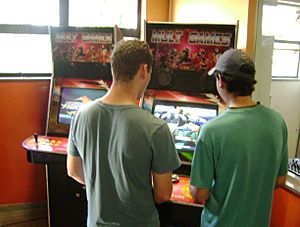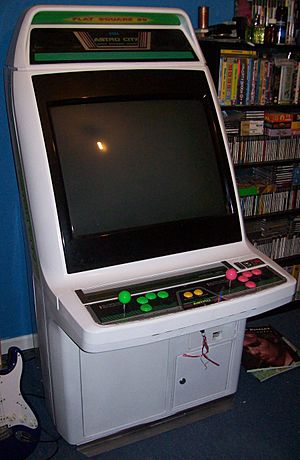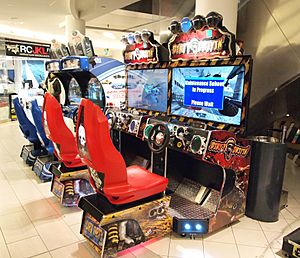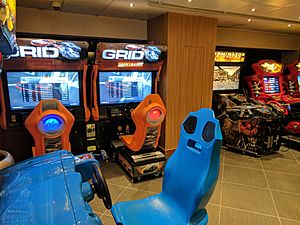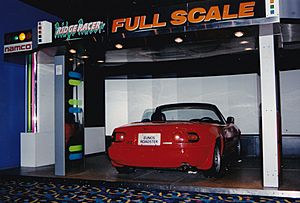Arcade cabinet facts for kids
An arcade cabinet, also known as an arcade machine, is the big box that holds all the parts of an arcade game. This includes the screen, controls, and the computer inside. Many cabinets made since the mid-1980s follow a special wiring rule called JAMMA. This makes it easier to put different games into the same cabinet.
Contents
What's Inside an Arcade Cabinet?
Arcade cabinets can look different depending on the game they hold. But most of them have these main parts:
- A screen where you see the game. This can be a regular screen or one that shows older, simpler graphics. Screens usually have a certain number of lines and refresh quickly. Some games use more than one screen. Newer cabinets might even have high-definition screens.
- Speakers for the game's sounds and music. These sounds often come from special sound chips.
- Circuit boards (PCBs) or arcade system boards. These are the actual computers that run the game. They are hidden inside the cabinet. Some systems use a main board where you can plug in different game cartridges.
- A power supply that gives electricity to the game boards and lights up the coin slots.
- A marquee. This is a sign above the screen that shows the game's title. Marquees are usually bright and lit up.
- A bezel. This is the frame around the screen. It might have game instructions or cool artwork.
- A control panel. This is a flat area near the screen where all the game controls are. You might find playing instructions here too. Players often stack their coins on this panel.
- Coin slots, coin returns, and the coin box. These are where you put your money or tokens to play. They are usually below the control panel. Sometimes, a red button lets you get your coin back if it gets stuck. Some arcades now use card readers instead of coin slots.
The sides of arcade cabinets are often decorated with colorful stickers or paint. These designs usually show what the game is about.
Different Kinds of Cabinets
There are many types of arcade cabinets. Some are made just for one game. The most common types are the upright, the cocktail or table, and the sit-down cabinets.
Upright Cabinets
Upright cabinets are the most common type, especially in North America. They are usually made of wood and metal. They stand about six feet (two meters) tall. The control panel is at about waist height, and the screen is at eye level inside the cabinet. The marquee is above the screen.
Early arcade games had screens that faced straight out. Later, some screens were angled and used a mirror to show the game. This allowed for cool effects like adding extra images or colors to black-and-white screens. When color screens became common, the mirrors were no longer needed.
Most upright cabinets have a joystick and action buttons for players. They also have "player" buttons to start the game. Some games use trackballs instead of joysticks. Others use spinners (knobs) for moving things horizontally or vertically. Games like Robotron: 2084 use two joysticks. Some fighting games even had pressure-sensitive pads instead of buttons.
For driving games, upright cabinets might have a steering wheel and gas pedal. Shooting games might have light guns attached. Some cabinets had the screen at the bottom with a mirror to save space. Other games, like Guitar Freaks, have controllers that look like musical instruments.
Upright cabinets can be simple boxes or have unique shapes. Most games are for one or two players. However, some games, like Gauntlet, have controls for up to four players.
Sit-down or Table Cabinets
Cocktail Cabinets
Cocktail cabinets look like low, rectangular tables. The controls are usually at the ends, and the screen is inside the table, facing up. For two-player games, players take turns. The screen flips around so each player sees the game correctly when it's their turn. This needs special game programming.
These cabinets were very popular in the 1980s, during the Golden Age of Arcade Games. They were smaller than upright cabinets and seemed less noticeable. The top of the table was covered with strong glass, so people could even put drinks on it. This is why they are called "cocktail" cabinets. You often saw them in bars and pubs.
Candy Cabinets
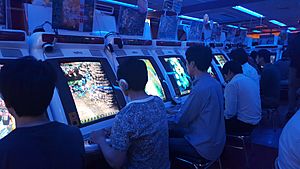
These cabinets are often called "candy cabinets" because their plastic parts look like hard candy. They are usually easier to clean and move than upright cabinets. Players sit on a chair or stool to play for a long time. Many Japanese arcade games use this type of cabinet. In Japanese arcades, you often see many candy cabinets lined up neatly.
A special type, called "versus-style" cabinets, looks like two cabinets facing each other. They have two screens and separate controls. This lets two players fight each other without sharing a screen. Some newer cabinets can do this by connecting to each other.
Deluxe Cabinets
Deluxe cabinets (also called DX cabinets) are often used for games like racing or flight simulators. These cabinets usually have controls that look like they belong in a vehicle. For example, driving games might have a seat, foot pedals, a stick shift, and a steering wheel. Flight games might have a flight stick. Motorcycle games have handlebars and a seat shaped like a real bike.
These cabinets are often placed side-by-side so players can compete. Sega and Namco are big makers of these cabinets. Namco even made a Ridge Racer game where you sat in a real car dashboard!
Cockpit or Environmental Cabinets
A cockpit or environmental cabinet is a type of deluxe cabinet where the player sits inside the cabinet itself. It often has walls around the player. Examples include shooting games like Star Wars and racing games like Pole Position.
Motion Simulator Cabinets
A motion simulator cabinet is a very fancy deluxe cabinet. It has hydraulics that move the player based on what's happening in the game. In Japan, these are called "taikan" games, meaning "body sensation." Sega is famous for making many types of motion cabinets since the 1980s.
Motorbike games like Hang-On let the player sit on a motorbike replica and lean to control the game. Driving games like Out Run have seats that move. Flight simulators like After Burner also use moving cockpits. One of the most amazing is Sega's R360, which can spin the player a full 360 degrees, just like a real aircraft!
Mini or Cabaret Cabinets
Mini or cabaret cabinets are smaller versions of arcade cabinets. Modern mini cabinets are sold for homes and are scaled down to fit easily. They still look like standard upright cabinets with artwork. Older mini cabinets were made for arcades but were thinner and shorter. They had less artwork and smaller screens. This made them cheaper and lighter, good for smaller spaces.
Countertop Cabinets
Countertop or bartop cabinets are small enough to sit on a bar or table. They usually only hold the screen and controls. They are often used for trivia or gambling games in pubs and restaurants. Many of these cabinets have touchscreens instead of buttons. They are also popular for home use.
Large-scale Satellite Machines
These machines are mostly found in Japan. They have many screens connected to one main system, sometimes with a huge screen in the middle. These games often give out special cards. These cards can save your game progress or be used as trading cards within the game.
Conversion Kit
An arcade conversion kit is special equipment that can change the game an arcade machine plays. For example, a kit can turn a machine playing Street Fighter II: Champion Edition into Street Fighter II Turbo.
Bringing Old Cabinets Back to Life
Since old arcade games are becoming popular to collect, there's a whole area focused on fixing them up. Many websites and groups share tips on how to make old games look new again.
Artwork
Sometimes, arcade cabinets were used for many different games over time. Often, when a new game was put in, the old artwork on the sides was painted over, usually black. This was to make sure the cabinet showed the correct game. It also hid any damaged or faded artwork.
Collectors prefer cabinets with their original artwork in good condition. Since these are hard to find, one of the first steps is to remove old paint or artwork. New paint can be put on in any way, like with a roller or spray. Many games had artwork printed right on the cabinet. Others used large stickers. Some companies now make copies of the original artwork for popular classic games. These new stickers can be very big and need to be put on carefully to avoid bubbles.
Control Panels, Bezels, Marquees
Finding these parts can be harder than putting them on. Many collectors trade these items online. Just like with side art, some shops make copies of the original artwork for these parts. These copies can look just like the originals, or even better. Once you have them, they usually snap right into place.
If the controls are worn out, you can often find new ones, especially for popular games. Controls for rarer games are harder to find. Some shops make stronger replacement controls that fit many machines. Putting them in might take some practice, but it's usually not too hard.
Monitors
Screens in arcade cabinets can be tricky to fix. Older screens are harder or more expensive to repair because some parts are no longer made. Finding a replacement for an old screen can also be a challenge.
Some electronic parts inside a cabinet can wear out from the heat. If an old arcade cabinet still has its original parts, it might be close to the end of its life. A common step in fixing old electronics is replacing certain parts to make sure the screen and power work safely. This should only be done by people with experience, as it can be dangerous. If a screen is broken, it might be easier to just find a new one from a parts supplier.
Wiring
If a cabinet needs new wires, you can find wiring kits online. Someone with experience can usually fix most wiring problems by trying different things.
Many cabinets are changed to play a different game than they were made for. If both games use the JAMMA standard, it's simple. Other changes can be harder. However, some companies like Nintendo made kits to help with these changes.
See also
 In Spanish: Máquina de arcade para niños
In Spanish: Máquina de arcade para niños
- Arcade game
- Slot machine
- Video arcade
- Arcade system board
- JAMMA
- MAME


